Abstract
The effect of intravenous infusion of isoproterenol on myocardial oxygen consumption (ṀVo2) was studied in 10 intact and anesthetized dogs before and after inhibition of lipolysis. In five dogs lipolysis was inhibited by nicotinic acid or beta pyridyl carbinol and in five other dogs by high plasma glucose concentrations. In spite of similar mechanical responses to isoproterenol, as evidenced by left ventricular pressure, maximal rate of rise of left ventricular pressure (dP/dt), heart rate and cardiac output, augmentation of ṀVo2 was larger before (on average 7.6 ml/min·100 g) than after inhibition of lipolysis either by antilipolytic drugs (on average 4.5 ml/min·100 g) (P < 0.005), or by high plasma glucose concentrations (on average 4.3 ml/min·100 g) (P < 0.02). As mechanical responses to isoproterenol were similar before and after inhibition of lipolysis, it is concluded that the additional rise in ṀVo2 with intact lipolysis was caused by a metabolic stimulation by high concentrations of free fatty acids.
Full text
PDF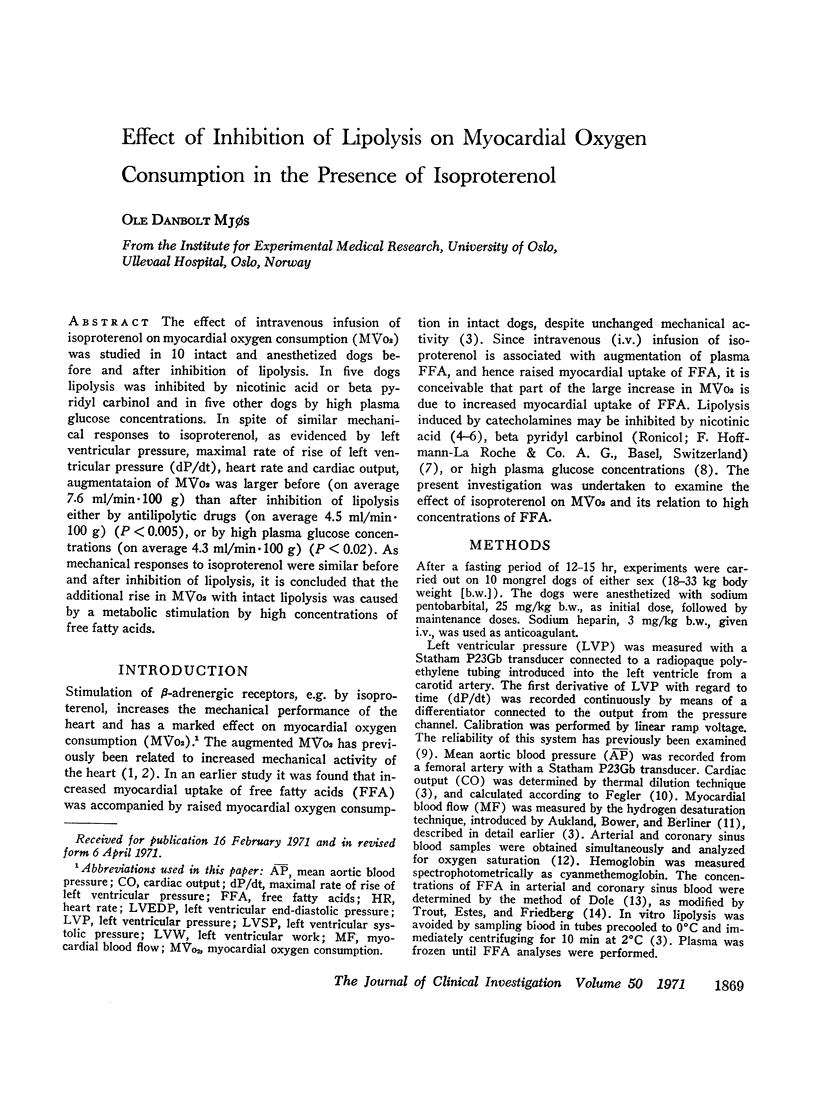
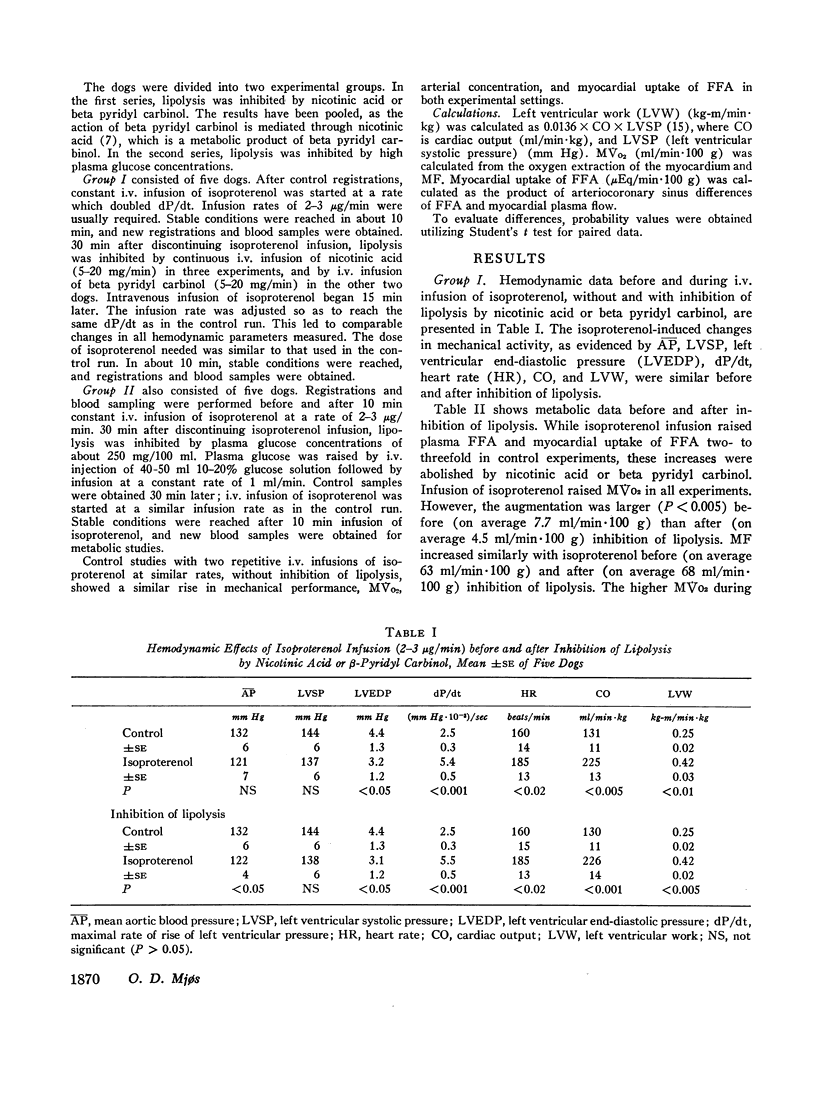
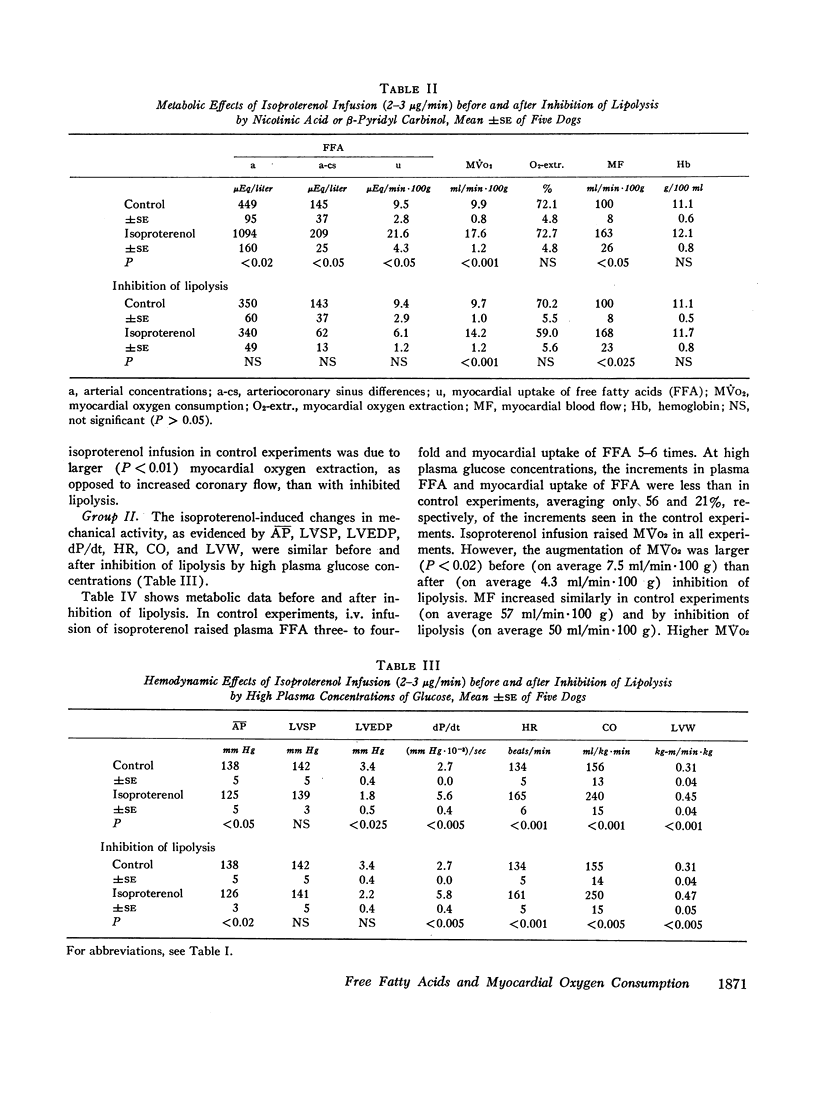
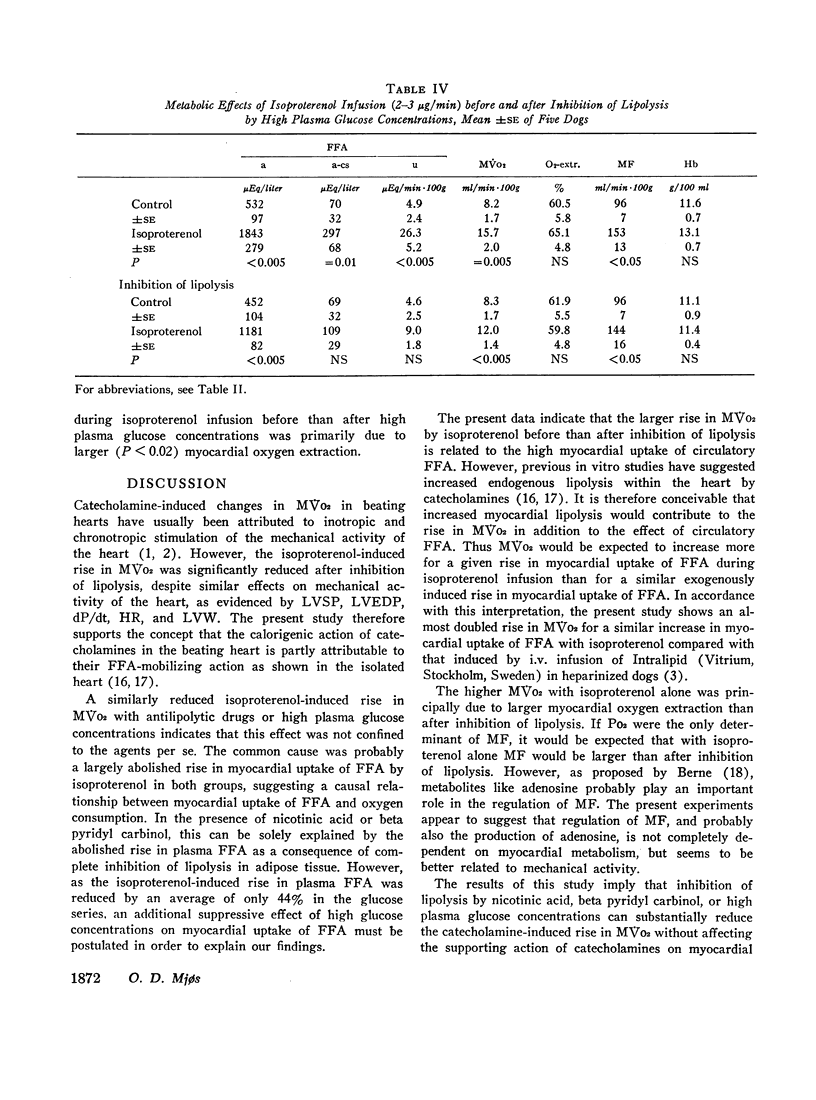
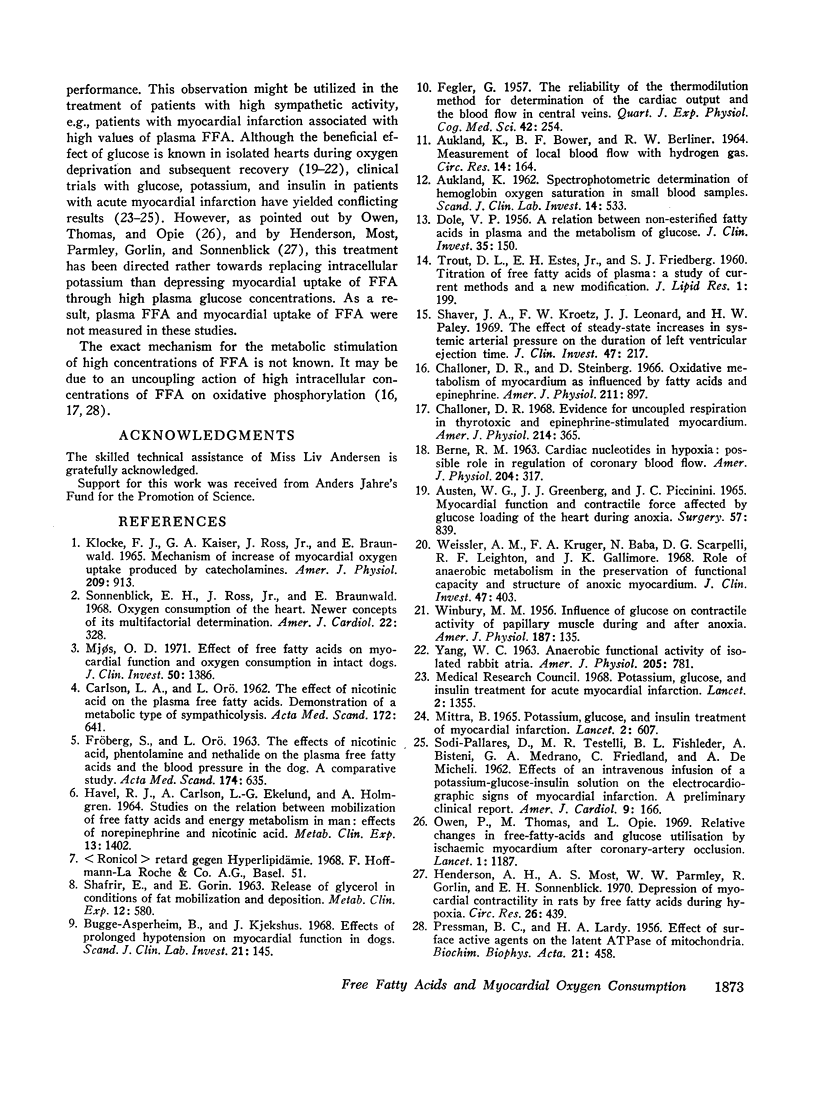
Selected References
These references are in PubMed. This may not be the complete list of references from this article.
- AUKLAND K., BOWER B. F., BERLINER R. W. MEASUREMENT OF LOCAL BLOOD FLOW WITH HYDROGEN GAS. Circ Res. 1964 Feb;14:164–187. doi: 10.1161/01.res.14.2.164. [DOI] [PubMed] [Google Scholar]
- AUKLAND K. Spectrophotometric determination of hemoglobin oxygen saturation in small blood samples. Scand J Clin Lab Invest. 1962;14:533–536. doi: 10.3109/00365516209051275. [DOI] [PubMed] [Google Scholar]
- AUSTEN W. G., GREENBERG J. J., PICCININI J. C. MYOCARDIAL FUNCTION AND CONTRACTILE FORCE AFFECTED BY GLUCOSE LOADING OF THE HEART DURING ANOXIA. Surgery. 1965 Jun;57:839–845. [PubMed] [Google Scholar]
- BERNE R. M. Cardiac nucleotides in hypoxia: possible role in regulation of coronary blood flow. Am J Physiol. 1963 Feb;204:317–322. doi: 10.1152/ajplegacy.1963.204.2.317. [DOI] [PubMed] [Google Scholar]
- Bugge-Asperheim B., Kjekshus J. Effects of prolonged hypotension on myocardial function in dogs. Scand J Clin Lab Invest. 1968;21(2):145–156. doi: 10.3109/00365516809084277. [DOI] [PubMed] [Google Scholar]
- CARLSON L. A., ORO L. The effect of nicotinic acid on the plasma free fatty acid; demonstration of a metabolic type of sympathicolysis. Acta Med Scand. 1962 Dec;172:641–645. doi: 10.1111/j.0954-6820.1962.tb07203.x. [DOI] [PubMed] [Google Scholar]
- Challoner D. R. Evidence for uncoupled respiration in thyrotoxic and epinephrine-stimulated myocardium. Am J Physiol. 1968 Feb;214(2):365–369. doi: 10.1152/ajplegacy.1968.214.2.365. [DOI] [PubMed] [Google Scholar]
- DOLE V. P. A relation between non-esterified fatty acids in plasma and the metabolism of glucose. J Clin Invest. 1956 Feb;35(2):150–154. doi: 10.1172/JCI103259. [DOI] [PMC free article] [PubMed] [Google Scholar]
- FEGLER G. The reliability of the thermodilution method for determination of the cardiac output and the blood flow in central veins. Q J Exp Physiol Cogn Med Sci. 1957 Jul;42(3):254–266. doi: 10.1113/expphysiol.1957.sp001261. [DOI] [PubMed] [Google Scholar]
- FROEBERG S., OROE L. THE EFFECTS OF NICOTINIC ACID, PHENTOLAMINE AND NETHALIDE ON THE PLASMA FREE FATTY ACIDS AND THE BLOOD PRESSURE IN THE DOG. A COMPARATIVE STUDY. Acta Med Scand. 1963 Nov;174:635–641. [PubMed] [Google Scholar]
- HAVEL R. J., CARLSON L. A., EKELUND L. G., HOLMGREN A. STUDIES ON THE RELATION BETWEEN MOBILIZATION OF FREE FATTY ACIDS AND ENERGY METABOLISM IN MAN: EFFECTS OF NOREPINEPHRINE AND NICOTINIC ACID. Metabolism. 1964 Dec;13:1402–1412. doi: 10.1016/0026-0495(64)90034-4. [DOI] [PubMed] [Google Scholar]
- Henderson A. H., Most A. S., Parmley W. W., Gorlin R., Sonnenblick E. H. Depression of myocardial contractility in rats by free fatty acids during hypoxia. Circ Res. 1970 Apr;26(4):439–449. doi: 10.1161/01.res.26.4.439. [DOI] [PubMed] [Google Scholar]
- Klocke F. J., Kaiser G. A., Ross J., Jr, Braunwald E. Mechanism of increase of myocardial oxygen uptake produced by catecholamines. Am J Physiol. 1965 Nov;209(5):913–918. doi: 10.1152/ajplegacy.1965.209.5.913. [DOI] [PubMed] [Google Scholar]
- LARDY H. A., PRESSMAN B. C. Effect of surface active agents on the latent ATPase of mitochondria. Biochim Biophys Acta. 1956 Sep;21(3):458–466. doi: 10.1016/0006-3002(56)90182-2. [DOI] [PubMed] [Google Scholar]
- Mittra B. Potassium, glucose, and insulin in treatment of myocardial infarction. Lancet. 1965 Sep 25;2(7413):607–609. doi: 10.1016/s0140-6736(65)90516-7. [DOI] [PubMed] [Google Scholar]
- Mjos O. D. Effect of free fatty acids on myocardial function and oxygen consumption in intact dogs. J Clin Invest. 1971 Jul;50(7):1386–1389. doi: 10.1172/JCI106621. [DOI] [PMC free article] [PubMed] [Google Scholar]
- Owen P., Thomas M., Opie L. Relative changes in free-fatty-acid and glucose utilisation by ischaemic myocardium after coronary-artery occlusion. Lancet. 1969 Jun 14;1(7607):1187–1190. doi: 10.1016/s0140-6736(69)92168-0. [DOI] [PubMed] [Google Scholar]
- SHAFRIR E., GORIN E. Release of glycerol in conditions of fat mobilization and deposition. Metabolism. 1963 Jul;12:580–587. [PubMed] [Google Scholar]
- SODI-PALLARES D., TESTELLI M. R., FISHLEDER B. L., BISTENI A., MEDRANO G. A., FRIEDLAND C., DE MICHELI A. Effects of an intravenous infusion of a potassium-glucose-insulin solution on the electrocardiographic signs of myocardial infarction. A preliminary clinical report. Am J Cardiol. 1962 Feb;9:166–181. doi: 10.1016/0002-9149(62)90035-8. [DOI] [PubMed] [Google Scholar]
- Shaver J. A., Kroetz F. W., Leonard J. J., Paley H. W. The effect of steady-state increases in systemic arterial pressure on the duration of left ventricular ejection time. J Clin Invest. 1968 Jan;47(1):217–230. doi: 10.1172/JCI105711. [DOI] [PMC free article] [PubMed] [Google Scholar]
- Sonnenblick E. H., Ross J., Jr, Braunwald E. Oxygen consumption of the heart. Newer concepts of its multifactoral determination. Am J Cardiol. 1968 Sep;22(3):328–336. doi: 10.1016/0002-9149(68)90117-3. [DOI] [PubMed] [Google Scholar]
- TROUT D. L., ESTES E. H., Jr, FRIEDBERG S. J. Titration of free fatty acids of plasma: a study of current methods and a new modification. J Lipid Res. 1960 Apr;1:199–202. [PubMed] [Google Scholar]
- WINBURY M. M. Influence of glucose on contractile activity of papillary muscle during and after anoxia. Am J Physiol. 1956 Sep;187(1):135–138. doi: 10.1152/ajplegacy.1956.187.1.135. [DOI] [PubMed] [Google Scholar]
- Weissler A. M., Kruger F. A., Baba N., Scarpelli D. G., Leighton R. F., Gallimore J. K. Role of anaerobic metabolism in the preservation of functional capacity and structure of anoxic myocardium. J Clin Invest. 1968 Feb;47(2):403–416. doi: 10.1172/JCI105737. [DOI] [PMC free article] [PubMed] [Google Scholar]
- YANG W. C. ANAEROBIC FUNCTIONAL ACTIVITY OF ISOLATED RABBIT ATRIA. Am J Physiol. 1963 Oct;205:781–784. doi: 10.1152/ajplegacy.1963.205.4.781. [DOI] [PubMed] [Google Scholar]


